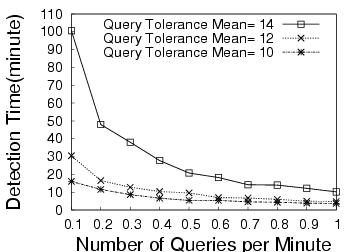
|

Detecting sensor failure is critical in PRESTO since the absence of pushes is assumed to indicate an accurate model. Thus, failures are detected only when the proxy sends a pull request or a feedback message to the sensor, and obtains no response or acknowledgment.
Figure 7 shows the detection latency using implicit heartbeats and random node failures. The detection latency depends on the query rate, the model precision and the precision requirements of queries. The dependence on query rate is straightforward--an increased query rate increases the number of queries triggering a pull and reduces failure detection latency. The relationship between failure detection and the model accuracy is more subtle. Model accuracy depends on two factors--the time since the last push from the sensor, and model uncertainty that captures inaccuracies in the model. As the time period between pushes grows longer, the model can only provide progressively looser confidence bounds to queries. In addition, for highly dynamic data, model precision degrades more rapidly over time triggering a pull sooner. Hence, even queries with low precision needs may trigger a pull from the sensor. The failure detection time also reduces with increase in precision requirements of queries. For instance, for a query rate of 0.1 queries/minute, the detection latency increases from 15 minutes when queries require high precision to 100 minutes when the queries only require loose confidence bounds.
The worst-case time taken for failure detection is one day since this is the frequency with which a feedback message is transmitted from the proxy to each sensor. However, this worst-case detection time occurs only if a sensor is very rarely queried.
Summary: Our results show that sensor failure detection in PRESTO is adaptive to data dynamics and query precision needs. The PRESTO proxy can detect sensor failures within two hours in the typical case, and within a day in the worst case.